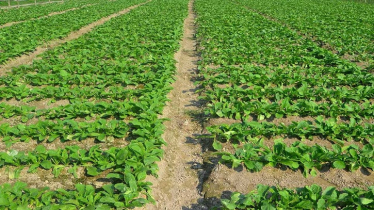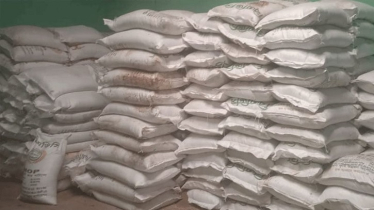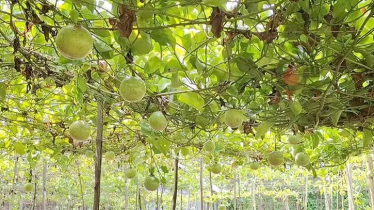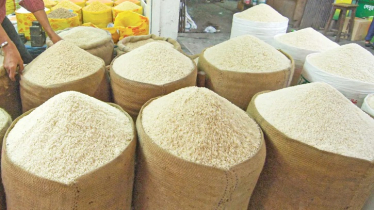
Since signing the Paris Agreement in 2015, the role of Bangladesh in the climate movement has been quite visible. As per the agreement, Bangladesh, along with the other signatory countries, has to submit its GHG emission data and the mitigation strategies in action as a document called "Nationally Determined Contribution (NDC)" of GHG emission to UNFCCC with the intention of regulating global temperature increase within 2°C above the pre-industrial level while maintaining economic growth. Every few years, updates to the NDC strengthen its commitment. The first report was submitted in 2015, called Intended Nationally Determined Contribution (INDC), and the updated version, NDC 2.0, in 2021. Now Bangladesh is getting ready with its recent version, the NDC 3.0 for 2025.
Emission Baseline and Projections
The energy sector contributed the highest share of GHG emissions at 55.07%, amounting to 93.09 Mtons CO₂e, followed by Agriculture, Forestry, and Other Land Use (AFOLU) with 46.24 MtCO₂e, which represents 27.35%. The base year was set as 2012, when the total national GHG emissions were 169.05 Mtons CO₂e. Without any control measures (business as usual: BAU), total GHG emissions are expected to increase to 409.41 MtCO₂e by 2030. For AFOLU, the base year emission of 46.24 MtCO₂e is expected to increase to 55.01 MtCO₂e by 2030. This total GHG was quite steep in a few years due to the contribution of the energy sector. The contribution of AFLOU is not as significant as the contribution of the energy sector, but it still deserves attention as the second-highest contributor of GHG.
NDC 2.0 Targets (2021 Update)
Bangladesh was supposed to reduce 1.04 MtCO₂e from AFLOU emissions through the NDC 2.0 target by 2030, out of which the amounts of unconditional and conditional were 0.64 and 0.40 MtCO₂e, respectively. The highest share of reductions was expected from rice cultivation, fertiliser management, livestock feed, and manure management, which were supposed to be 1.16% below the BAU scenario by 2030.
Key Mitigation Strategies for Agriculture under NDC 2.0
The main goal of NDC 2.0 for reducing greenhouse gas emissions from agriculture was to lower methane emissions from rice fields by using AWD irrigation technology, encouraging short-duration rice varieties, and applying better fertiliser management practices like urea deep placement.
For livestock, it was suggested to replace low-productive native breeds with productive crossbreed animals, provide improved-quality feed, and establish a mini biogas plant for managing manure.
Achievements So Far
In NDC 2.0, Bangladesh set targets for AWD in rice cultivation and manure management through biogas plants. For AWD, the goal was 150,000 hectares (50,000 unconditional and 100,000 conditional) by 2030, but progress has been minimal with only 1,312 ha (219 ha unconditional) achieved so far—less than 1% of the target. A large pipeline project (120,000 ha) under a carbon trading initiative with Japan is in development, but adoption challenges such as farmer reluctance, lack of training, funding constraints, and infrastructure gaps have slowed progress. We have not yet given special attention to extending the short duration of rice varieties and implementing smart fertiliser management practices.
According to the Sustainable and Renewable Energy Development Authority (SREDA), Bangladesh’s solar irrigation capacity is 57.83 MWp. The International Water Management Institute's (IWMI) SoLAR project notes 1,337 pumps producing 28 MW, while Mongabay (a US-based independent, nonprofit environmental news media organisation) reports 2,226 pumps installed by NGOs and private initiatives. Despite progress, actual installations remain far below NDC 2.0 targets, reflecting a significant implementation gap. In contrast, the biogas plant programme has shown better results. Bangladesh has installed 87,582 plants instead of the pledged no. of 164,000 units (57,000 unconditional and 107,000 conditional). No visible development is seen in the case of reducing enteric methane emissions, as the research results are yet to be made available to the extension personnel.
NDC 3.0: A Forward-Looking Framework
The draft NDC 3.0 takes the NDC 2.0 strategies further by outlining more applied and sector-specific actions for 2030 and 2035. In agriculture (crop subsector), as per NDC 2.0, the plan seeks to scale up AWD to cover 50,000 hectares unconditionally and 100,000 hectares conditionally by 2030, expanding further to 30% of Boro rice fields by 2035. Of this 10%, a portion will be classified as unconditional, while the remainder will be classified as conditional. The plan also places emphasis on precision agriculture technologies, short-duration rice varieties, and the production of biochar from agricultural waste. By 2035, the energy use in agriculture will complement national renewable energy goals with the deployment of nearly 45,000 solar irrigation pumps. In the livestock sector, NDC 3.0 proposes replacing millions of low-productive animals with crossbred cattle, improving feed for large and small ruminants, and enhancing manure management through biogas, vermicompost, and biochar production. Importantly, the conditional actions explicitly link to international climate finance, concessional loans, and carbon market mechanisms.
NDC 3.0 Weakness of Forward-Looking Framework
Crop: As NDC 2.0, practising AWD irrigation is the principal method recommended for growing rice to minimise GHG emission in NDC 3.0. The crop diversification and innovative cropping system, including upland crops (crops grown under rainfed conditions or with little irrigation), like pulses, oil crops, and jute, are not included in the NDC 3.0 mitigation practices. Even agronomic practices, such as the dry- or wet-seeded method, which can mitigate methane emissions by using minimal water during crop establishment, are not included in NDC 3.0.
Here are the recommendations to overcome the weakness in mitigation of GHG emissions:
- A strategic, carefully calibrated shift of 5–10% of rice land to diversified upland crops is attainable without affecting total rice production.
- Diversify cropping systems by promoting direct dry-seeded rice culture (dry or wet) and upland crops in an intensive rice–rice cropping system.
- Introduce pulses and oil crops to improve soil health.
- Strengthen research and development of short-duration, water-efficient, upland Aus rice varieties and genetically low-emission rice varieties.
- Support farmers with capacity building and incentives to encourage adoption of improved practices and technologies.
Livestock: Livestock contributes significantly to AFLOU through enteric fermentation and manure management. The target was too ambitious to satisfy in NDC 2.0 for enteric fermentation. To mitigate GHG emissions from livestock due to enteric fermentation in NDC 3.0, no explicit programme on livestock appears to be reported (as per the presentation in an Inter-Ministry Consultation Meeting on the AFLOU sector on 9 August 2025). The reasons may include a lack of updated research data, the absence of new technology developed since NDC 2.0, scarcity of funding, and existing policy barriers. To reduce the gap, the government may seek external assistance as conditional actions from the external funding sources.
Recommendations
- Maintain livestock targets (animal replacement, feed improvement, manure management) under NDC 3.0 as conditional measures for seeking international intervention.
- Finance the research and extension programme to build vigorous livestock MRVs (methane measurement, productivity tracking) to lower uncertainty.
- Proactively engage with international donors and global trading mechanisms to position livestock as a finance-ready mitigation opportunity.
Aquaculture
Despite its rapid expansion, aquaculture’s contribution to GHG emissions is still not under consideration in NDC 3.0 as it was in NDC 2.0. Recent studies estimate that fisheries currently emit around 3.68 million tonnes of CO₂ equivalents of GHGs each year—comprising 1.87% of national emissions and nearly 5% of agriculture-related emissions. The GHGs are methane from anaerobic decomposition in pond and floodplain aquaculture and nitrous oxide from feed and fertiliser input. Given the increasing tendency of aquaculture, these emissions are projected to rise, potentially making aquaculture a significant contributor within AFOLU. To address this gap, Bangladesh should incorporate aquaculture into NDC 3.0 by:
Recommendations
- Developing a baseline GHG inventory for aquaculture.
- Introducing mitigation strategies such as improved feed efficiency, optimised fertiliser use, water aeration, integrated rice–fish, etc.
- Align aquaculture mitigation efforts as conditional actions and seek investment from international institutions for financial and technical support.
Challenges to Implementation
Despite a significant response from the Government of Bangladesh, there are a lot of obstacles to implementing NDC effectively. The main obstacle is the scarcity of domestic financial support to satisfy the unconditional target. To satisfy the conditional target, it has to be exclusively dependent on international climate finance or the like. There are also limitations in data and weaknesses in the MRV system. In addition, balancing the apparent antagonistic relationship between self-sufficiency in food and GHG emission is a challenge when the staple food is rice in a country like Bangladesh. Strengthening institutional capacity, establishing robust Measurement, Reporting, and Verification (MRV) systems, and ensuring community participation in climate initiatives is a must to address these challenges.
Bangladesh has played a proactive role with strong determination in the climate journey from the Intended Nationally Determined Contribution (INDC) in 2015 to the development of NDC 3.0. Although Bangladesh is not a major emitter of GHG, its role in the international arena must be in the principle of “common but differentiated responsibilities” under the Paris Agreement. Success depends on international cooperation in finance, technology, capacity building, training, and extension.
Bangladesh’s climate commitments demand integrating agricultural modernisation with low-carbon strategies. The Reducing Agricultural Methane Program (RAMP), launched in recent years by the International Fund for Agricultural Development, can provide funding capacity and technical support. With the international financial backup, Bangladesh can accelerate its diversification in agriculture and adopt sustainable technologies to satisfy its NDC targets while maintaining food security and resilience in rural communities.
The writer is the Senior Technical Consultant on Reducing Agricultural Methane for the Asia and the Pacific Region at the International Fund for Agricultural Development (IFAD)





